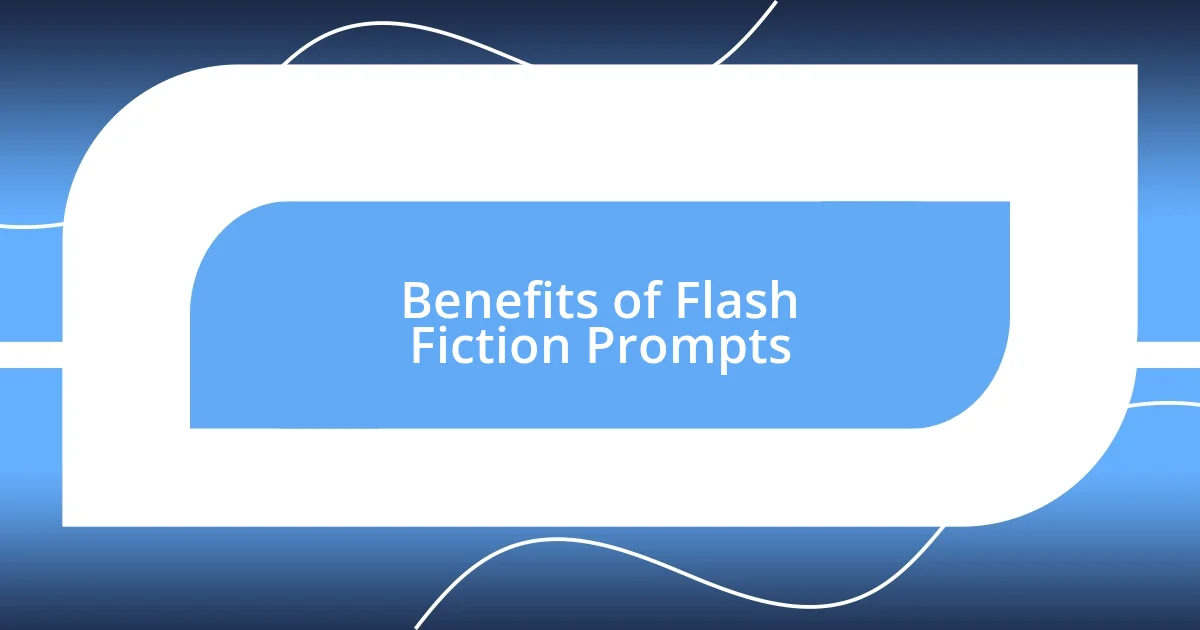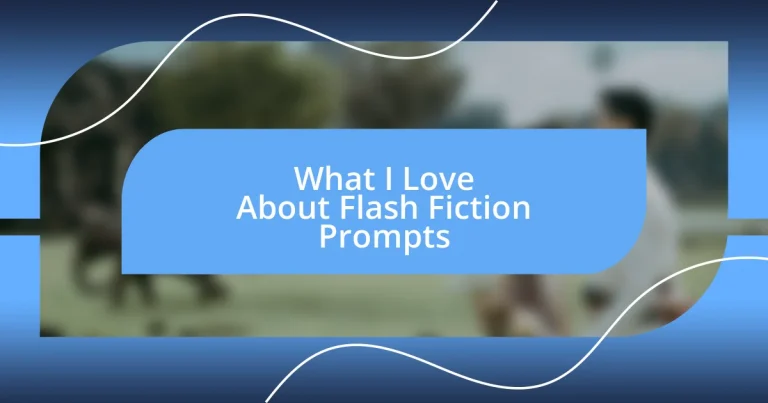Key takeaways:
- Flash fiction prompts ignite creativity by encouraging concise expression and emotional exploration, often leading to unexpected narratives.
- Effective techniques include writing dialogues, merging prompts, and setting time limits to enhance spontaneity and character depth.
- Prompts help overcome writer’s block by pushing boundaries, evoking nostalgia, and allowing for personal reflection in storytelling.

Understanding Flash Fiction Prompts
Flash fiction prompts serve as a creative spark, igniting the imagination with just a few carefully chosen words or phrases. I remember sitting at my desk, staring at a blank page, when I stumbled upon a prompt about an abandoned umbrella. It was such a simple object, yet it led to a whirlwind of ideas about lost connections and forgotten memories. Isn’t it fascinating how a single prompt can unlock a floodgate of emotions and stories?
What I find most compelling about these prompts is their ability to challenge writers to be concise. You’re forced to dig deeper into your thoughts, distilling complex emotions into a limited word count. I’ve had moments where I felt overwhelmed by the constraints, but then realized they pushed me to think outside the box and explore angles I hadn’t considered before. Don’t you find it liberating to write within boundaries that ultimately free your creativity?
Moreover, flash fiction prompts can evoke contrasting feelings. One day, I was inspired by a prompt about a thunderstorm; I felt dread and excitement, blending uncertainty with anticipation. The next day, a simple image of a sunlit kitchen flooded me with warmth and nostalgia. This duality is what keeps me coming back for more prompts. It’s like opening a door to various states of being—what doors do you think your prompts could open?

Benefits of Flash Fiction Prompts
Engaging with flash fiction prompts is like gifting yourself a daily dose of creativity. Each prompt presents an opportunity to explore feelings and ideas that often lurk just beneath the surface. I recall once writing a piece inspired by a prompt that suggested a “lost letter.” This simple idea drew me into a profound exploration of regret and longing, weaving a narrative that resonated deeply with my own experiences. It reminded me that the smallest sparks can ignite the most meaningful flames of creativity.
Here are some benefits of flash fiction prompts:
– Enhanced Creativity: They encourage you to think outside the box and explore themes you might not usually address.
– Concise Expression: With a limited word count, you learn to convey ideas succinctly, a skill that’s invaluable in all forms of writing.
– Diverse Emotional Range: Writing prompts can evoke a wide spectrum of emotions, helping you tap into different aspects of your personality.
– Regular Writing Practice: They provide a consistent way to practice writing, fostering discipline and habit.
– Community Engagement: Sharing your responses can connect you with other writers, offering fresh perspectives and support.

Creative Techniques for Using Prompts
One creative technique I often use with prompts is to write a dialogue between two characters inspired by a single phrase. For instance, when prompted with “the last train,” I imagined a conversation between two strangers at the station, sharing hopes and fears as they wait. This method not only allows me to explore character dynamics but also adds depth to the narrative, transforming a brief moment into a meaningful exchange.
Another approach I find effective is to merge two unrelated prompts to create a unique story. I once combined “an empty suitcase” with “a forgotten birthday.” The result was a tale about a traveler who missed a significant date while pursuing dreams, which revealed a bittersweet reflection on choices. This technique challenges me to link seemingly disparate ideas, revealing surprising connections and insights that enrich the story.
I also enjoy setting strict time limits when responding to prompts. Giving myself just 10 or 15 minutes to flesh out an idea encourages spontaneity and prevents overthinking. I remember a session where I wrote about “a message in a bottle.” The pressure of time led to a raw and emotional piece that I probably wouldn’t have written in a leisurely setting. This thrill of urgency often inspires my best work!
| Technique | Description |
|---|---|
| Dialogue Writing | Create character conversations based on a prompt. |
| Merging Prompts | Combine two prompts for unexpected narratives. |
| Time Limits | Set strict limits to enhance spontaneity. |

Tips for Writing with Prompts
When working with prompts, I find it incredibly useful to embrace a playful mindset. Sometimes, I’ll write the first thing that pops into my head when I see a prompt, even if it feels silly at first. For example, the prompt “whispers in the attic” led me down an unexpectedly whimsical path where I created a story about a mischievous ghost that only communicated through playful riddles. Isn’t it interesting how tapping into that playful energy can transform a simple idea into something magical?
Another tip I’ve discovered is to write without any self-judgment during the initial draft. I remember sitting down with a prompt about “a forgotten photograph,” feeling anxious about where to start. I pushed through the discomfort by reminding myself that this was just a rough draft, a space to explore rather than a polished piece. This approach allowed my thoughts to flow freely, and by the end, I had crafted a story that surprised even me. Have you ever noticed how lifting that pressure can unlock creativity?
Lastly, revisiting prompts after a while can be incredibly rewarding. I once picked up a prompt about “the last smile” months after the initial spark. My perspective had shifted, bringing new layers and emotions to the piece. I found myself reflecting on the bittersweet nature of goodbyes in a way that felt more profound than my first attempt. Isn’t it fascinating how time and experience shape our voices? Sometimes, what we write one day may bloom into something entirely different with just a little time.

Overcoming Writer’s Block with Prompts
When faced with writer’s block, prompts can feel like a lifeline. There’s something liberating about reading an unexpected phrase and allowing it to take my thoughts in new directions. Just the other day, I encountered the prompt “a forgotten toy.” Instead of crafting a typical tale, I found myself reminiscing about my childhood and the emotions surrounding nostalgia. This emotional connection not only freed my creative flow but also gave depth to what initially seemed like a simple idea.
I often encounter days when my creativity feels stifled, but prompts have a way of breaking that barrier. For example, I remember sitting down to respond to the prompt “the sound of silence.” It felt intimidating at first, but I let my imagination wander, and suddenly, I was exploring the concept of isolation through a character’s experiences during a power outage. This process revealed layers of emotion I hadn’t expected, turning a mundane moment into something poignant and relatable. Has a single phrase ever opened up a whole world of ideas for you?
The beauty of using prompts, I’ve learned, lies in their ability to push you beyond your comfort zone. When I came across a seemingly odd prompt about “the last leaf,” I felt my mind initially resist the challenge. However, embracing that discomfort led to a story about change and resilience, reflecting my own experiences. Isn’t it amazing how a simple sentence can lead us to discover more about ourselves through our characters? It’s moments like these that truly affirm the power of prompts in overcoming creative blocks.












